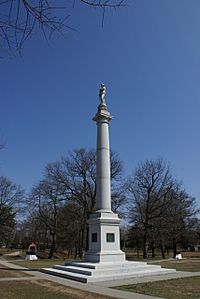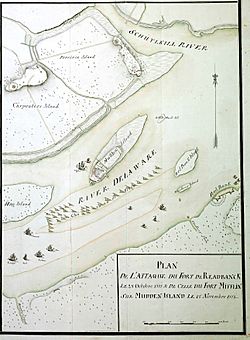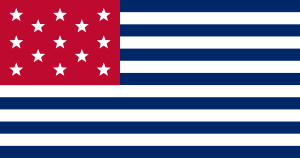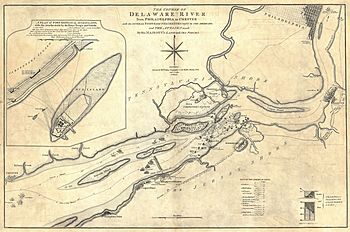Battle of Red Bank facts for kids
Quick facts for kids Battle of Red Bank |
|||||||
|---|---|---|---|---|---|---|---|
| Part of the American Revolutionary War | |||||||
 Monument at Fort Mercer |
|||||||
|
|||||||
| Belligerents | |||||||
|
|
|||||||
| Commanders and leaders | |||||||
| Strength | |||||||
| 400 American Patriots | 1,200 Hessian troops | ||||||
| Casualties and losses | |||||||
| 14 killed 23 wounded |
82 killed 228 wounded 60 captured |
||||||
The Battle of Red Bank happened on October 22, 1777, during the American Revolutionary War. It was a fight where British and Hessian soldiers tried to capture Fort Mercer. This fort was on the New Jersey side of the Delaware River, just south of Philadelphia.
However, a much smaller group of American defenders strongly defeated them. Even though the British took Fort Mercer a month later, this victory was very important for the Americans. It gave them a much-needed boost in morale. It also slowed down the British plans to take full control of Philadelphia. Plus, it helped ease the pressure on General George Washington's army, which was north of the city.
Why the Battle Happened
The British captured Philadelphia on September 26, 1777. Then, the Americans tried a surprise attack at the Battle of Germantown on October 4, but it failed. After this, the Americans wanted to stop the British from using Philadelphia. They decided to block the Delaware River.
To do this, they built two forts that controlled the river. One was Fort Mercer in New Jersey, at a place called Red Bank. The other was Fort Mifflin, on an island in the Delaware River in Pennsylvania. As long as the Americans held both forts, British navy ships could not reach Philadelphia to bring supplies to their army.
The Americans also had a small fleet of ships on the Delaware River. This fleet included ships from the Continental Navy and the Pennsylvania Navy. It had sloops, schooners, galleys, and even old ships filled with tar. These ships had about 100 cannons in total, led by Commodore John Hazelwood.
The British fleet, led by Admiral Howe, had about nine warships and several transport ships. These ships were fully staffed and had 285 cannons just on the warships. Admiral Howe had more officers and men on just two of his ships than Commodore Hazelwood had in his entire American fleet.
On October 18, General Sir William Howe, the leader of the British Army, moved his troops into Philadelphia. He sent some of his forces to capture the two American forts that were blocking the Delaware River. Earlier, Howe had sent men to build artillery batteries to attack Fort Mifflin. The first attack on Fort Mifflin happened on October 11. This attack was not very strong, so the British decided to make their batteries bigger and better.
Meanwhile, 2,000 Hessian soldiers, led by Colonel Carl von Donop, landed in Camden, New Jersey. This was about 4 miles (6.4 km) upriver from Fort Mercer. They got ready to attack the fort, which was on high ground at Red Bank. The fort had 400 American soldiers and 14 cannons. The Americans were not scared.
At 4 p.m., Donop sent an officer to demand that the Americans surrender. He warned that if they fought, they would not be shown any mercy. Colonel Greene, who led the fort's defenders, quickly replied, "We ask no quarters, nor will we give any." This meant they would not surrender and would fight to the end. Since Donop thought the fort was not well-defended, he decided to attack directly. He even said, "We'll change the name from Fort Red Bank to Fort Donop."
The Battle Begins

Colonel von Donop had been defeated before at the Second Battle of Trenton. He really wanted to win this battle to make up for that loss. He told his soldiers, "Either that will be Fort Donop or I shall be dead."
Donop soon realized how hard his task was. He asked General Howe for more cannons, but Howe told him to wait for the British fleet to come up the river. Howe also said that if Donop couldn't capture the fort, the British would. This order seemed to make Donop feel insulted.
On October 20, 1777, five British warships, led by Captain Hamond, sailed up the river. They passed through the lower chevaux-de-frise, which were underwater obstacles. One of these ships was the HMS Augusta, a large ship with 64 cannons.
Von Donop split his 1,200 soldiers into two groups for a two-part attack on the fort on the morning of October 22. Von Donop and Lieutenant Colonel von Linsing were to attack the southern part of the fort. Colonel Friedrich Ludwig von Minnigerode's soldiers and Lieutenant Colonel Werner von Mirbach's infantry were to attack the northern and eastern sides.
With five British warships in the river ready to help, von Donop was sure he would capture the fort by nightfall. After the Hessian cannons fired, Linsing's men moved towards the southern wall, which was nine feet high. But they were hit by heavy cannon and musket fire from the Americans and had to retreat.
On the north side, Minnigerode's soldiers managed to climb over the walls of an empty part of the fort. But when they moved forward, they faced a thick barrier of fallen trees with sharp branches. This was a type of obstacle called an abatis. They had few tools and were soon seen trying to get through the barrier. The Americans, waiting on the other side, fired at them. The American and Pennsylvania navies also fired at the Hessians from the side, hitting many of them.
The Hessians suffered many losses and began to retreat. They went back to their camp about 10 miles (16 km) away in Haddonfield. Von Donop was wounded in the leg during the southern attack. His retreating troops left him on the battlefield. He died three days later from his wounds in a farmhouse near the fort.
To make things worse for the British and Hessians, the six British warships were attacked by smaller American gunboats. During this fight, two of the British ships, the 64-gun HMS Augusta and the HMS Merlin, got stuck on a sandbar. They were trying to avoid the underwater obstacles called chevaux-de-frise, which were rows of large wooden spears designed to pierce ship hulls. Attempts to free the ships overnight failed.
The next morning, Fort Mifflin and the Pennsylvania Navy attacked the stranded ships with cannons and fire rafts. The Augusta caught fire. Within an hour, the fire reached the ship's gunpowder storage, and the ship exploded. The explosion was so powerful that people in Philadelphia could hear it. The Augusta was the largest ship the British lost in both the Revolutionary War and the War of 1812. The exact cause of the fire is not clear, but some believe it was accidental. Soon after, the crew of the Merlin was told to leave their ship and destroy it too.
What Happened Next
The Hessian army reported that 377 of their soldiers were killed or wounded, and 20 were missing or captured. The Americans reported only 14 killed and 27 wounded.
General Howe was upset that they failed to capture Fort Mercer. He ordered the Hessian soldiers to leave New Jersey. He then planned a huge cannon attack on Fort Mifflin. By early November, the British cannons on Providence Island were ready, and several warships were there to help.
On November 10, 1777, the British began a massive attack on Fort Mifflin that lasted for five days. Six British warships, along with two small floating batteries, also joined the attack. They fired at Fort Mifflin from close range. After five days, on November 15, the commander of Fort Mifflin, Major Simeon Thayer, had 250 casualties out of his 400 men. He was also running low on ammunition. That evening, he left the fort, leaving the American flag flying, and moved his men to Fort Mercer. The next morning, a small group of British soldiers landed at the empty Fort Mifflin, took down the American flag, and raised the British flag. The attack on Fort Mifflin cost the British only 13 soldiers and sailors killed and 24 wounded.
Howe then sent Lord Cornwallis with 2,000 men to attack Fort Mercer. They landed by ferry at Billingsport, about 3 miles (4.8 km) to the south. Instead of letting his soldiers be captured by a huge British attack, Colonel Christopher Greene decided to leave Fort Mercer on November 20. The British then took over the fort the next day.
George Washington's plan to starve the British out of Philadelphia failed when the Americans lost both forts. His only hope now was to get the British to leave Philadelphia and fight another big battle near his camp at White Marsh. Although Howe did come out of the city to pretend to attack the American camp in early December, he felt the American position was too strong. He then went back to Philadelphia for the rest of the winter. Washington then moved his army to Valley Forge for the winter.
Red Bank Today
Today, the place where the Battle of Red Bank happened is a park called Red Bank Battlefield Park. It is part of the Gloucester County Parks system.
The park is 44 acres (17.8 hectares) big and is open to visitors during the day. The Whitall House, where von Donop died, can be visited during certain hours. Every October, people hold a yearly reenactment of the battle at the park.



